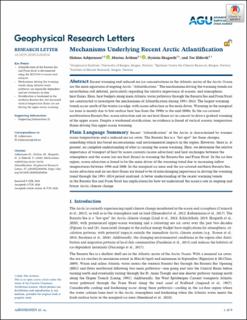| dc.contributor.author | Asbjørnsen, Helene | |
| dc.contributor.author | Årthun, Marius | |
| dc.contributor.author | Skagseth, Øystein | |
| dc.contributor.author | Eldevik, Tor | |
| dc.date.accessioned | 2020-12-15T12:05:08Z | |
| dc.date.available | 2020-12-15T12:05:08Z | |
| dc.date.created | 2020-11-30T21:28:02Z | |
| dc.date.issued | 2020 | |
| dc.identifier.citation | Geophysical Research Letters. 2020, 47:e2020GL088036 (15), 1-9. | en_US |
| dc.identifier.issn | 0094-8276 | |
| dc.identifier.uri | https://hdl.handle.net/11250/2719542 | |
| dc.description.abstract | Recent warming and reduced sea ice concentrations in the Atlantic sector of the Arctic Ocean are the main signatures of ongoing Arctic “Atlantification.” The mechanisms driving the warming trends are nevertheless still debated, particularly regarding the relative importance of oceanic and atmospheric heat fluxes. Here, heat budgets along main Atlantic water pathways through the Barents Sea and Fram Strait are constructed to investigate the mechanisms of Atlantification during 1993–2014. The largest warming trends occur south of the winter ice edge, with ocean advection as the main driver. Warming in the marginal ice zone is mainly due to low surface heat loss from the 1990s to the mid‐2000s. In the ice‐covered northwestern Barents Sea, ocean advection and air‐sea heat fluxes act in concert to drive a gradual warming of the upper ocean. Despite a weakened stratification, no evidence is found of vertical oceanic temperature fluxes driving this upper‐ocean warming. | en_US |
| dc.language.iso | eng | en_US |
| dc.title | Mechanisms underlying recent Arctic atlantification | en_US |
| dc.type | Peer reviewed | en_US |
| dc.type | Journal article | en_US |
| dc.description.version | publishedVersion | en_US |
| dc.source.pagenumber | 1-9 | en_US |
| dc.source.volume | 47:e2020GL088036 | en_US |
| dc.source.journal | Geophysical Research Letters | en_US |
| dc.source.issue | 15 | en_US |
| dc.identifier.doi | 10.1029/2020GL088036 | |
| dc.identifier.cristin | 1854538 | |
| cristin.ispublished | true | |
| cristin.fulltext | original | |
| cristin.qualitycode | 2 | |
